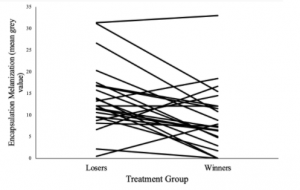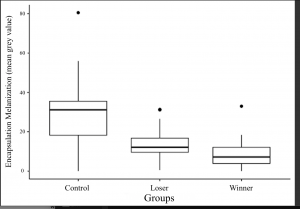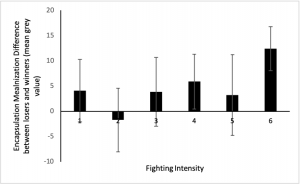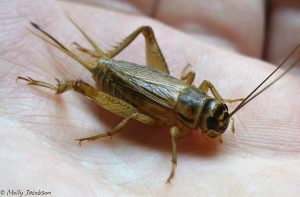3 The Effects of Fighting on the Immune Responses of Acheta Domesticus Crickets
Sydney Szwed; Colin Blackwell; and Rohan Patel
Abstract
Animals often undergo courtship displays to attract mates, especially using effective aggression. This holds true for insects as well, and specifically in crickets, displays of dominance, such as antennal fencing and mandible flexing, are used to make the other male submissive and woo the female. These displays, as well as preparation for reproduction, have energy costs, however. Similarly, the immune system also costs energy to function properly, but it plays an important role in ridding the body of foreign substances. In crickets, one way the immune system does this is encapsulation of these foreign bodies with melanin, which inhibits the substance and allows the rest of the immune system to break down a potentially harmful substance. Since both systems cost energy, the cricket’s energy should be prioritized and allocated between these systems to fulfill innate instincts, such as mating, while also keeping the animal alive with the immune system. This leads to the question of how effective is the immune system a dominant male expecting mate, versus that of a submissive male that lost to the other? Using two sexually mature males and a female, two males were fought to determine the dominant of the two. Both males, as well as control crickets who did not fight, were then encapsulated with nylon threads to cause the immune system of the crickets to encapsulate these threads in melanin. Then, using imaging software, the melanin content on the threads was compared to see how the immune responses of the two pairs varied. Ultimately, it was determined that while the crickets involved in a fight had a lower encapsulation level than the controls, however, the encapsulation level between the fighters was not significant. Still, there appeared to be a higher mean encapsulation level among the losers when compared to the winners. This shows that while energy is allocated away from the immune system for both fighting males, the outcome of the fight has no significant effect on this tradeoff. This likely can apply to other insects and could affect higher-order species with similar courtship displays.
Research question
If a male cricket is seen to dominant in a competition fight, how will its subsequent immune response be affected as a result of energy allocation and fitness trade-offs between aggression and immune function? Will fight intensity further affect encapsulation abilities?
Overview
Fighting is a necessary way for many animals to gain resources in the natural world, and the winner of these fights often gets the most resources. One of these important resources are mates, as producing offspring is something that naturally drives many animals as well. Still, animals have a maximum amount of energy they possess. Therefore, only a limited amount of energy can be spent on fighting and reproduction, as other crucial systems require energy to function, too. One of these systems is the immune response system, which plays an important role in keeping the animal alive by fighting off foreign bodies that have entered the body. There are multiple ways the immune system fights these invaders, but efficiency comes at a cost, and the immune system requires energy to function effectively. Therefore when animals engage in fights, and when they prepare to reproduce, they have to limit the energy spent on the immune system, therefore weakening their line of defense towards illnesses and parasites. This leads to the question of whether an animal who wins the fight for a mate will have a weaker immune system than the male who was beaten in the fight. Crickets were used as a means to test this. Sexually mature males were placed in a container with a female to cause them to fight. Then to test their immune response, a nylon thread was inserted into their abdomen. One of the unique responses the immune system of crickets have is encapsulation. When the immune system of the cricket finds a foreign body, hemocytes, which are similar to our white blood cells, will trigger a response that causes cells to surround the foreign body. These cells then are melanized to become hardened and dark, which then starves the invasive organism or allows for it to be broken down. To understand how the immune system was working, a computer program measured the level of melanin on the thread, and it was then compared to a thread that was not inserted in a cricket to gauge how strong the immune systems of each cricket was. Controls were also used, which were crickets that did not engage in a fight, to see if there was a change in the immune system efficiency whether or not they fought. Ultimately, when a cricket fought, it had a lower level of immune efficiency than crickets that did not fight. Additionally, while there was not a significant difference between them, crickets that did lose the fight had a higher average level of immune response than the winners, indicating that energy tradeoff occurred because of the fight, and on a smaller level, whether the male expected to mate because it won.
Background
In many species, females tend to mate with males who display superior qualities. Examples of superior qualities are size, build, and dominance. In some species, like Acheta domesticus crickets, a female’s presence will provoke two males to participate in a competitive fight in which dominance can be established. Although these fights are energetically costly for the crickets, aggression is important in obtaining reproductive success and increasing fitness. Another aspect influencing an organisms’ fitness is the immune function. Without proper immune function, an organism will be unable to fight pathogens successfully and can succumb to infection. Invoking proper immune response is extremely energetically costly for organisms, but vital for survival. While competition fights and immune function are both seen to increase crickets’ fitness, how do energy trade-offs between these two functions work? If a cricket is seen to exert energy to a competition fight, how will a subsequent immune response be affected?
Methods
Preparation:
In our experiment, we randomly selected 60 males and 8 female adult A. domesticus crickets and recorded their weight and age. Our experimental group included 50 male crickets that fought each other. Our control group included 10 males that did not fight; however, we still triggered an immune response (via encapsulation rate assay which is inserting a nylon thread into the cricket) to compare with responses of the fighting crickets.
Fighting procedure:
For each trial, we placed two males into the fighting container and recorded their activity and fight intensity (ranking from 0-6) for 5 minutes. Zero is considered avoidance by both crickets, and a 1 ranking is where one cricket avoids the other. Followed by 2, antennal fencing, then 3, mandible spreading by one cricket, and 4 is mandible spreading by both crickets. Next, 5 ranks as mandible engagement, and finally 6 represents grappling (the most intense kind of fighting). A winner and loser of the encounter were then determined based on which cricket was more aggressive and spent more time near the female.
Encapsulation Rate Assay:
To measure the immune response of the crickets, we used an encapsulation rate assay because this method is an accurate and relatively simple measurement of the immune system. The encapsulation method measures the efficiency of an immune response by inserting a nylon thread between the sternites of the cricket which will act as a foreign pathogen (such as a virus or bacteria) triggering the immune system. During an infection, there is a series of reactions which causes the melanization on the thread and the death of the invading pathogen. Melanization is what determines the color of the thread which can be used as a measurable immune response value. Quantifying the immune responses allows us to compare the responses between each cricket.
To measure encapsulation, we inserted a sterile nylon-thread in between the second and third sternite (found on the side of the cricket) and left the thread inside of each cricket for 24 hours. After we removed the thread, we took a picture of it under a microscope. We measured the immune system activity with an image processing system called “ImageJ” which calculated the mean grey values of light reflected from the threads (simply said, it measures the melanization). A greater melanization value indicates a greater immune response.
Results
After the 25 fights and 10 control trials, we conducted the encapsulations for all the crickets. Two of these trials had a fight intensity of zero, which is equivalent to no fight at all. We removed these trials for all tests and calculations.
All of our tests and calculations were calculated in the “RStudio” program. Our first compared the encapsulation melanization pairs of winners and losers for all the trials (Figure 1). The losers had significantly higher melanization values than its paired winner (t = 3.0774, sample size = 23, p = 0.005509). Our second test looked at the melanizations of the losers, winners, and control crickets as groups (figure 2). The melanization values of control crickets were significantly greater than of losers and winners (loser-control, p-value =0.0006065; winner-control, p-value = 0.0000128). However, there was no significant difference when comparing the mean melanization values of winners to losers as a group of values.
Another test we performed looked to see if fighting intensity impacted the difference in melanization between losers and winners. The results indicated that fighting intensity significantly increased the melanization encapsulations (df = 5, p-value = 0.0421). Our final test compared the fighting intensities between each other (for example: the 1-5 comparison compares the melanization of the crickets with fighting intensities 1 and 5) (figure 3). Of the 15 comparisons, only the comparison between fighting intensities 2 and 6 was significant (p adj. = 0.0190196).



Figure 1) Top Image // Figure 2) Middle Image // Figure 3) Bottom Image
Interpretation
Our pairwise comparison (paired t-test) displayed that losers had significantly higher melanization rates than their paired winners. This strengthens our hypothesis and helps answer how losing or winning a fight can impact the effectiveness of their immune responses. This indicates that losers spent less energy on aggression when fighting; therefore, they had more energy available for a greater immune response. Lower melanizations in winners mean that they had less energy available for their immune system. From this new relationship, we can assume that fighting plays an even greater role in resource allocation. Gaining knowledge further about these trade-offs insight would help expose what other biological functions are lacking essential energy.
The ANOVA test comparing the melanizations of the winners, losers, and control groups also displayed significant differences: melanization differences between the control group and losers were statistically significant as well as the differences between the control group and winners. The control group had much greater immune responses than the fighting groups. This is because they did not have to encounter a fight. If they did, they would be faced with a trade-off of deciding between allocating energy towards aggression or their immune response. Since these control crickets did not undergo this trade-off, it suggests they had more available energy to use for their immune system. The results of the controls support our hypothesis by strengthening the argument that engaging in a fight causes a trade-off between aggression and immune responses.
The other ANOVA test determined a significant relationship in the difference between melanizations of loser and winner pairs and their fighting intensities. Since we established a relationship between the treatment (losers and winners) and control groups, we conducted a Tukey-post-hoc test which allowed us to compare each level of fight intensity to all other intensity groups. Only 1 of the 15 comparisons were significant which was between the fighting intensity 2 and 6. This comparison was the driving force for the significance in the previous ANOVA test comparing the means of melanization differences with fighting intensities as groups. The established relationship between these two variables indicates that the intensity of fights is another factor decreasing the immune responses and hence resource allocation. This, however, is what we expected as past work has also found that aggression is costly and should impact the crickets’ trade-offs and resource allocation.
Significance and Applications
Our project set out to discover energy trade-offs between immune function and competition fights. Our project not only broadens the narrative of this subject, but demonstrates that A. domesticus function prioritization is circumstantial, and crickets will allocate energy when necessary. Furthermore, our research strives to highlight how aggression intensity affected encapsulation rates. Although we concluded that fight intensity did not affect the rates, we can also conclude that an energy trade-off between these two processes will occur regardless of how much energy was exerted within the fight.
These results could indicate a large portion about the energy tradeoffs due to male aggression during mating season, as opposed to the actual preparation for reproduction. The results of this experiment can largely be used to analyze insects that have similar behavioral patterns as crickets. Still, from a larger perspective, many animals have courtship displays, and the energetic tradeoffs are still prevalent in these higher species, so it is possible for information from this experiment to apply to them. This could allow for a greater understanding of ecological interactions between species and even hold medicinal or psychological value when understanding humans and the stress and cost of social interactions.
Future Research Directions
In the future, we would like to investigate how the environment in A. domesticus affect fitness. Dominance and immune response could be “condition-dependent”, meaning certain conditions, such as environment and resource abundance, could cause crickets to demonstrate superiority without trade-offs taking place. We would like to study how environmental conditions could promote overall better fitness, or conversely, which conditions could hinder a cricket’s dominance or immune function.
Suggested Reading
- Short Overview of the Human Immune System for background: https://medlineplus.gov/ency/article/000821.htm
- What is a T-test?: https://www.statisticshowto.com/probability-and-statistics/t-test/
- What is an ANOVA test?: https://www.statisticshowto.com/probability-and-statistics/hypothesis-testing/anova/

